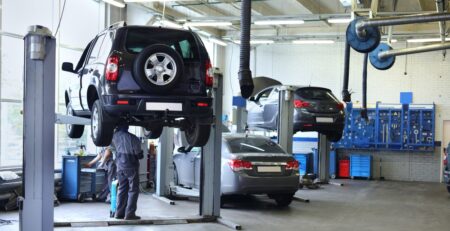A Guide To Automotive Repair Scheduling Software
There is no shortage of automotive appointment scheduling software available, all with robust features and intuitive technology. Automotive software is designed to help streamline the repair process and keep all personnel informed. The true value of investing in a good automotive repair scheduling software is that errors are reduced and repairs are more efficient, increasing customer satisfaction and attracting more business.
If you’re setting up a new auto repair shop, you’re expanding your current business, or you’re looking to update your dealership’s software, you’ve come to the right place. This guide will help you navigate through the variety of software options – here’s what to look for to narrow down what you need.
Cloud-based software
Cloud-based software eliminates the need for IT support and infrastructure, which is an added expense. More than that, cloud-based software allows you to check in on your shop from anywhere in the world with an Internet connection. This allows for greater flexibility and convenience and a system that can grow with your business. You can also rest assured that your data is protected and backed up.
Software integrations
One of the most time-consuming challenges with dealerships and auto repair shops is working with different software to tackle different jobs. For example, the parts department uses automotive inventory software and will need to toggle back and forth between different software to communicate with the service department on approvals and available parts. While this may take a minute or two, those minutes add up – and for busy service shops, that means hours wasted and opportunities lost.
Software integrations allow for better communication between departments and a more streamlined process. If your existing system does not have software integration, a solution to look into is a Production Efficiency Platform, which works with your existing software to optimize your workflow. With this plugin from Workflow 360, departments can easily communicate with each other and have a birds-eye-view of the repair process on one dashboard. Service advisors can move through each repair efficiently, which can increase turnaround time, reduce missed opportunities, and increase the company’s profit potential.
Two-way client communication
Maintaining communication with clients throughout the repair process builds trust and helps save valuable time. Look for two-way texting capabilities with SMS features that lets you store and send photos and videos of vehicle inspections. This allows clients to stay in the loop about where their vehicle is in the repair process and shortens approval time on repairs.
Real-time and trackable data
Gone are the days of using paper and pen to write down notes from customers and service advisors, store them in a growing file cabinet, and spend time searching through physical notes. Thankfully, digitization has solved this issue years ago. Now, the industry continues to improve with real-time information and trackable client history.
When a client calls to book a service appointment, service advisors can quickly access their file through the system and take a look at their service history, recommendations, and personal preferences such as whether the client prefers morning or afternoon appointments. If the client’s vehicle is already in the shop and they’re calling for an update, advisors have this information available with real-time updates on the right software and Workflow 360’s plugin. Furthermore, you and your team can stay on top of each repair and keep the job stacks moving. This not only makes for a more efficient process but happier customers!
At the end of the day, automotive software and plugins should save you time. If you’re experiencing bottlenecks with your current software, take a look at Workflow 360’s Production Efficiency Platform in action and how it can improve your processes.











